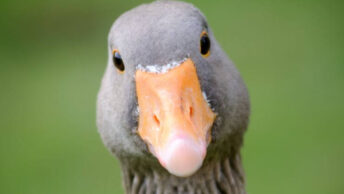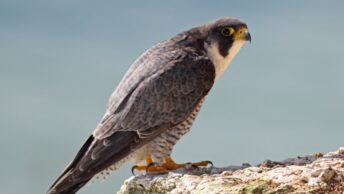Order Galliformes family Phasianidae
Galliformes are heavy-bodied birds that primarily feed on the ground, encompassing both domestic and game species. These birds typically have plump bodies, thick necks, and moderately long legs, along with rounded and relatively short wings. They are not capable of flying well, if at all, and instead rely on walking and running for mobility. Their sizes can vary significantly, ranging from 12 to 120 cm.
Many adult males possess one or more sharp, bony spurs on the back of each leg, which they use in fights. Gallinaceous birds can be found worldwide in various habitats, including forests, deserts, and meadows. Males engage in elaborate courtship behaviors that often include visually striking displays of their plumage.
Their diet is diverse and consists of both plant and animal materials, which can include fruits, seeds, leaves, shoots, flowers, tubers, roots, insects, snails, worms, lizards, snakes, small rodents, and eggs.
Some of the Galliformes families:
- Cracidae: Chachalacas, guans, and curassows.
- Numididae: Guineafowls.
- Odontophoridae: New World Quails.
Phasianidae: Pheasants, grouse, partridges, junglefowl, chickens, turkeys, Old World quail, and peafowl. - Megapodiidae: incubator birds, also known as mound builders, such as the malleefowl and brush-turkeys.
Grouse inhabit temperate and subarctic regions of the Northern Hemisphere. These robust birds, which belong to the Galliformes order, can range in size from 31 to 95 cm. Their legs are fully feathered down to their toes, and during winter, their toes also feature feathers or small scales on the sides. This adaptation enables them to walk on snow and burrow into it for shelter.
Unlike other Galliformes, grouse do not have spurs. While most grouses spend time on the ground, they may burst into flight if startled, gliding for significant distances. Their diet primarily consists of vegetation, including buds, catkins, leaves, and twigs. Many species that dwell in forests are particularly known for consuming large quantities of conifer needles, which are generally avoided by most other vertebrates.
1. Genus Bonasa
1.1. Ruffed Grouse (Bonasa umbellus)

Description: Ruffed Grouse are medium-sized birds with a chunky appearance and small crests that can sometimes be flattened. They are known for their extravagant displays and come in two distinct color morphs: one features a beige base with brown streaks, while the other has a gray mottled pattern. These grouse have pronounced ruffs on the sides of their necks, contributing to their variegated appearance. Additionally, their throats are often noticeably lighter than the rest of their bodies.
During their extravagant display, the long feathers in their necks stand erect, causing black ruffs, and they fan their tails, which are brownish-gray with regular barring and broad black subterminal bands. Both morphs of Ruffed Grouse have similar tail patterns.
Ruffed Grouse have hazelnut-brown eyes and dark brown bills, along with heavily scaled feet that vary in color from olive gray to brown. Although the sexes look quite similar, there are some distinctions. Females have broken subterminal bands and only one white dot on their tails, while males have two white dots.
- Length – 16.9-19.7 in (43-50 cm)
- Weight – 17.6-26.5 oz (500-750 g)
Similar to:
- Northern Bobwhites. Male Northern Bobwhites have white throats and black-bordered brow stripes, while females have tan-bordered brow stripes. Ruffed Grouse, on the other hand, exhibit plain faces.
- Spruce Grouse. Ruffed Grouse are characterized by their distinctive head crests, while Spruce Grouse do not have these crests. Male Spruce Grouse feature red markings above their eyes, a trait not found in male Ruffed Grouse. During courtship, Ruffed Grouse create loud drumming sounds by rapidly beating their wings, whereas the drumming of Spruce Grouse is much softer in comparison.
Habitat: Ruffed Grouse are found in mixed deciduous forests with a dense understory and secondary growth, often associated with aspen trees. During winter, they burrow into the snow for warmth.
Conservation: IUCN has listed Ruffed Grouse as Least Concern (LC).
Distribution: Ruffed Grouses are widespread and locally fairly common across northern North America, from the Appalachians to Alaska.
2. Genus Centrocercus
There are two species of sage-grouse. Adult birds have long, pointed tails and legs with feathers extending to their toes.
2.1. Greater Sage-Grouse, also Sage Grouse (Centrocercus urophasianus)

Description: Greater Sage-Grouse are large birds characterized by their chunky, rounded bodies, small heads, and long tails. They have finely speckled brown and gray upper parts. Males have white chests with fluffy white collars, black underparts, and dark brown throats. Their heads feature yellow fleshy crests above their eyes, along with long filoplume feathers that grow from the napes of their necks. These feathers become prominent when male grouse begin their display behaviors.
Greater Sage-Grouse display their starburst fanned tails, droop their wings and while inflating the bulbous yellow Gular air sacs on their chests, thrusting them forward to produce liquid popping sounds. Their eyes are amber, their bills are sepia, and their legs are fully feathered.
Females are smaller and have mottled gray-brown upper parts, light brown throats, and dark bellies. In comparison to males, females lack the distensible patches of bare skin on their chests and have smaller, duller, and more yellowish-green crests over each eye.
- Length – 25.6-29.5 in (65-75cm)
- Weight – 60-84.7 oz (1,700-2,900 g)
Greater Sage-Grouse are similar to Gunnison Sage-Grouse. Gunnison Grouse were formerly considered a subspecies of them. Gunnison Sage-Grouse are about one-third smaller than Greater Sage-Grouse, and male Gunnison Sage-Grouse have much thicker and longer neck plumes.
Habitat: Greater Sage-Grouse mainly inhabit sagebrush grasslands or juniper-dominated areas.
Conservation: IUCN has listed the Greater Sage-Grouse as Near Threatened (NT) due to the extensive loss and degradation of its habitat resulting from agricultural activities.
Distribution: Greater Sage-Grouse are found in the following states of the USA: California, Colorado, Idaho, Montana, Nevada, North Dakota, Oregon, South Dakota, Utah, Washington, and Wyoming. They are also found in Alberta and Saskatchewan in Canada.
2.2. Gunnison Sage-Grouse (Centrocercus minimus)
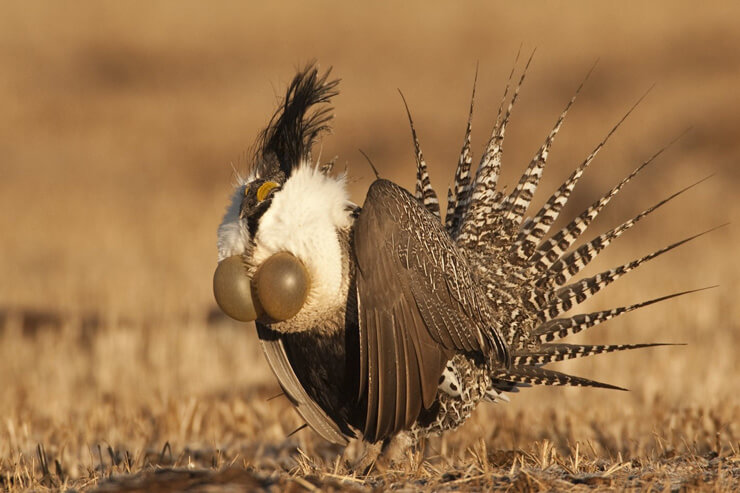
Description: Gunnison Sage-Grouse are characterized by their chunky, rounded bodies, small heads, and long tails. They have finely speckled brown and gray upper parts. Males have white chests with fluffy white collars, black underparts, and dark brown throats. Their heads feature yellow fleshy combs above their eyes, along with long thick filoplume feathers that grow from the napes of their necks. These feathers become prominent when male grouse begin their display behaviors.
Gunnison Sage-Grouse display their starburst fanned tails, droop their wings while inflating the bulbous yellow Gular air sacs on their chests, thrusting them forward to produce liquid popping sounds. Their eyes are amber, their bills are sepia, and their legs are fully feathered.
- Length – 12.6-20.1in (32-51 cm)
- Weight – 34.9-85.9 oz (990-2,435 g)
Gunnison Sage-Grouse are similar to Greater Sage-Grouse, and they were formerly considered subspecies of them. They are about one-third smaller than the Greater Sage-Grouse, and male Gunnison Sage-Grouse have much thicker and longer neck plumes.
Habitat: Gunnison Sage-Grouse are entirely dependent on sagebrush-dominated habitats.
Conservation: IUCN has listed the Gunnison Sage-Grouse as Endangered (EN) due to habitat loss, degradation, and fragmentation caused by the conversion of land to roads, reservoirs, livestock grazing, hay and other crops, real estate developments, power lines, land treatments, and increased deer populations.
Distribution: Gunnison Sage-Grouse occur in seven counties in southwestern Colorado and one county in southeastern Utah.
3. Genus Dendragapus
The Dusky Grouse and Sooty Grouse were formerly considered one species, known as the Blue Grouse.
3.1. Dusky Grouse (Dendragapus obscurus)
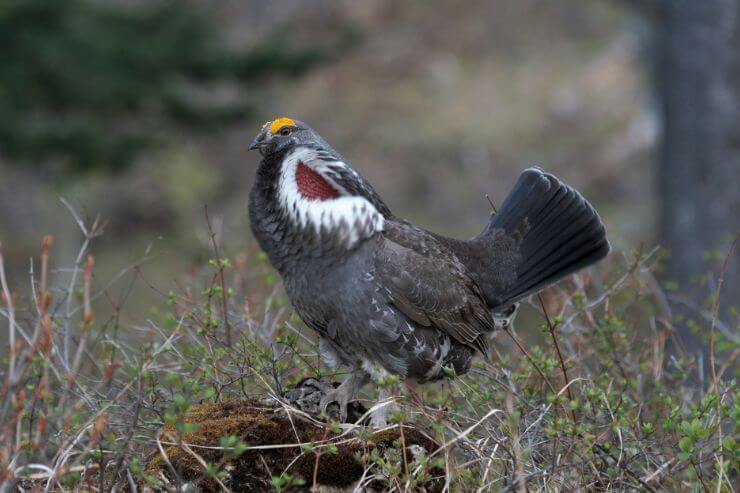
Description: Dusky Grouse are large, chicken-like birds with gray, brown, and black plumage, typically marked by white patches on their backs and wings. They have long, dark, square tails that have gray terminal bands. Males have yellow “combs” above their eyes that turn red during courtship and bare spots on their lower necks and upper chests that are reddish-purple, surrounded by bright white feathers that are exposed during display.
Dusky Grouses have hazelnut eyes, blackish bills, and feathered legs. Females are similar to males but are smaller, have a more brownish overall coloration, and are barred on their upper parts. Their necks are elongated and slender.
- Length – 17.3-22.4 in (44-57 cm)
- Weight – 41.3-44.8 oz (1,171-1,271 g)
Similar to Sooty Grouse. Dusky Grouses and Sooty Grouses have overlapping ranges, but Dusky Grouses have reddish-purple neck coloration, while Sooty Grouses have yellow necks.
Habitat: Dusky Grouses inhabit shrub-steppe and grasslands at the forest edges or along the perimeter of most montane forest communities with open tree canopies.
Conservation: The IUCN has listed the Dusky Grouse as Least Concern (LC).
Distribution: Dusky Grouses occur in mountainous regions of western North America, from southeastern Alaska and Yukon south to New Mexico.
3.2. Sooty Grouse (Dendragapus fuliginosus)

Description: Sooty Grouses are sturdy, chicken-like birds characterized by their mostly dark plumage and unique yellow Gular air sacs on their throats, which are surrounded by white. Males have yellow “combs” above their eyes that turn red during courtship and bare spots on their lower necks and upper chests that are yellow, surrounded by bright white feathers that are exposed during display. Additionally, their tails are long and square, with light gray terminal bands.
Sooty Grouses have hazelnut-colored eyes, black bills, and feathered legs. Females are mottled brown with dark brown and white markings on the underparts and have longer, slimmer necks than males.
- Length – 17.3-22.4 in (44-57 cm)
- Weight – 41.3-44.8 oz (1,171-1,271 g)
Similar to Dusky Grouses. Dusky Grouses and Sooty Grouses have overlapping ranges, but Dusky Grouses have reddish-purple neck coloration, while Sooty Grouses have yellow necks.
Habitat: Sooty Grouses are found in the edges of coniferous and mixed forests, specifically in mountainous regions and montane forests, ranging from the lower tree line to the alpine and subalpine tree lines. They prefer mature forests with a diverse range of plant and tree species. Additionally, they tend to inhabit areas that have been logged or burned, provided there is sufficient underbrush for nesting.
Conservation: IUCN has listed Sooty Grouse as Least Concern (LC).
Distribution: Sooty Grouses are endemic to the mountainous areas of western North America, from southern Alaska and northwestern British Columbia to California’s Sierra Nevada and west Nevada.
4. Genus Falcipennis
4.1. Siberian Grouse (Falcipennis falcipennis)
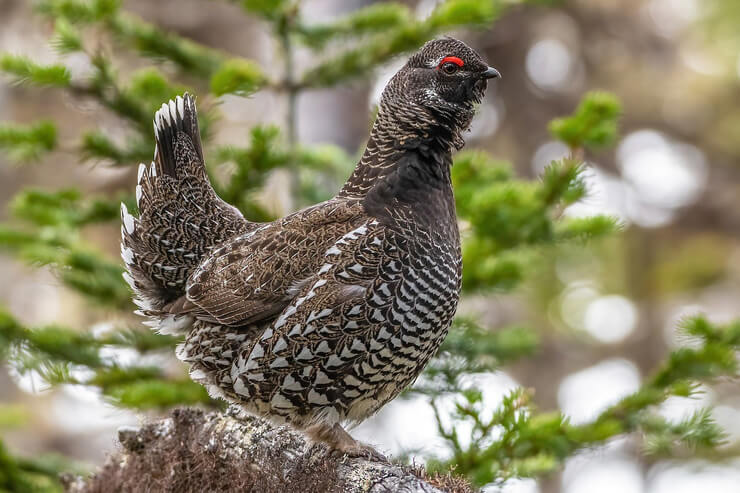
Description: Siberian Grouses are medium to large, stout birds. Males are characterized by their distinctive black throats, framed by a white rim, and a prominent red comb located above their eyes. Both males and females feature intricately speckled white underparts, along with white streaks on their wing coverts and rumps. Additionally, they have white terminal bands on their dark tails.
Siberian Grouses have dark brown eyes, black bills, and grayish-black legs. Females are smaller, more pale brown, and lack the distinct facial markings found in males.
- Length – 15-17 in (38-43 cm)
- Weight – 20.46-25.93 oz (580-735 g)
Habitat: Siberian Grouses inhabit well-shaded, humid coniferous and mixed forests, such as those comprising spruces, firs, larches, and pines. They prefer areas with dense shrub layers and abundant berries.
Conservation: IUCN has listed Siberian Grouse as Near Threatened (NT) due to widespread clear-cutting for timber, forest fires, and hunting for food.
Distribution: Siberian Grouses are primarily located in the far eastern region of Russia, encompassing Primorsky Krai, Khabarovsk Krai, the Amur Region, and Sakhalin Island.
4.2. Spruce Grouse (Falcipennis canadensis)
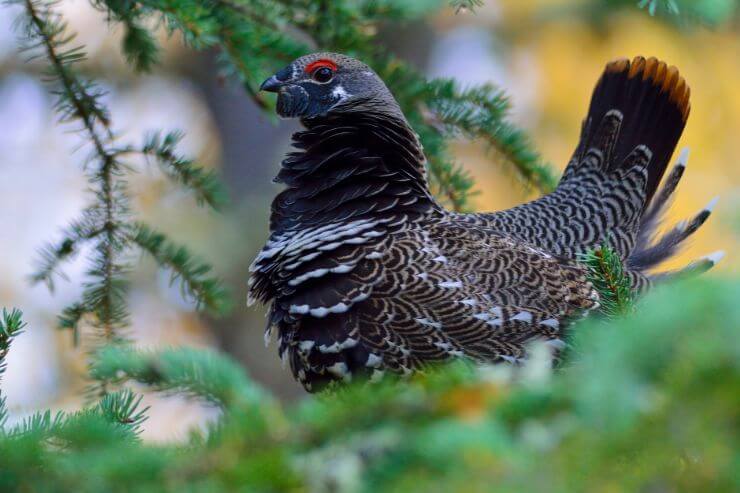
Description: Spruce Grouses are medium-sized birds characterized by their predominantly slate-gray upper parts. They have black tails with light tips and black underparts that feature scattered black feathers, which have white tips on the undersides of their chests and bellies. Additionally, these birds display spots on their flanks and a prominent red supercilium.
Spruce Grouses have amber eyes, sepia-colored bills, and feathered legs. Females exhibit two color morphs: mottled gray (gray morphs) and mottled chestnut (red morphs). Both morphs are generally lighter in color than the males and do not possess the distinctive red supercilium.
- Length – 15-17 in (38-43 cm)
- Weight – 19-23 oz (550-650 g)
Similar to:
- Ruffed Grouses. Ruffed Grouses have head crests; Spruce Grouses do not. Male Spruce Grouses have a red mark above their eyes; Ruffed Grouse males do not. During courtship, Ruffed Grouses beat their wings to produce a loud drumming sound; in comparison, Spruce Grouses drumming is soft.
- Siberian Grouses. Siberian Grouses and Spruce Grouses are very similar in appearance. Their ranges do not overlap.
Habitat: Spruce Grouses are typically found in conifer-dominated forests, including areas with pine, spruce, or fir trees, especially where moss covers the ground. They tend to prefer young, successional stands. During the summer, they are commonly located near rich understories of blueberries and other shrubs, while in the winter, they favor denser stands of trees. Spruce Grouses are usually seen on the ground or along roadsides, but they can also perch fairly high in the trees.
Conservation: IUCN has listed the Spruce Grouse as Least Concern (LC).
Distribution: Spruce Grouses are distributed across most of Canada and parts of the United States. In the U.S., they can be found in Alaska, northern New England, the Adirondacks in New York, northern Michigan, northeastern Minnesota, northern Wisconsin, as well as in Montana, Idaho, Maine, Oregon, and Washington.
5. Genus Tetrao
5.1. Black Grouse (Tetrao tetrix)
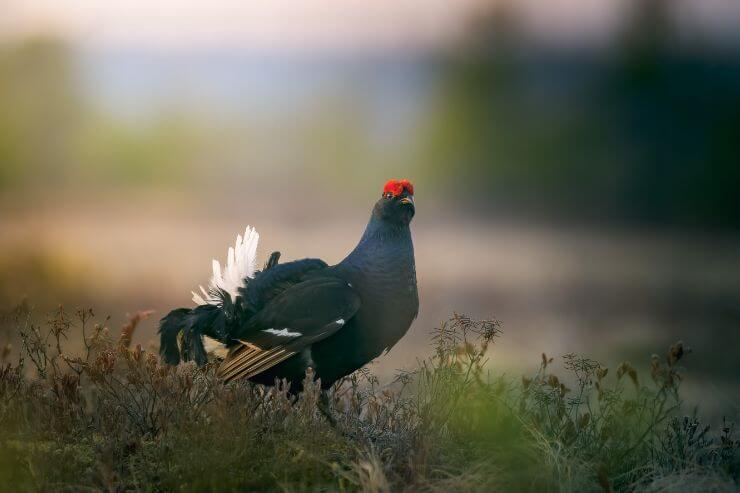
Description: Black Grouses are large birds in the grouse family, characterized by almost entirely black plumage with deep blue or green hues on their necks and backs. They have large conspicuous red “combs” above their eyes and show a striking white stripe along each wing in flight. They have small, white, round carpal spots. Their tails are lyre-shaped, with white undertails that become conspicuous when fanned out during displays by the males.
Black Grouses have hazel eyes, black bills, and feathered legs. Females are slightly smaller than males and are mostly brown with black barring. Females also have slightly notched tails.
- Length – 19.7-21.65 in (50-55 cm)
- Weight – 35.27-51.15 oz (1,000-1,450 g)
Habitat: Black Grouses are typically found in transitional zones between forests and open areas, such as steppes, heaths, moors, and peatlands. They generally prefer birch trees. In the winter, they gather in large flocks in dense forests, primarily feeding on the leaves and buds of both coniferous and broadleaf trees.
Conservation: IUCN has listed the Black Grouse as Least Concern (LC).
Distribution: Black Grouses are distributed across Europe, from Great Britain to Scandinavia and Russia, with a significant population in southern Siberia. They also inhabit parts of Kazakhstan, Mongolia, and China.
5.2. Black-billed Capercaillie (Tetrao Urogalloides)
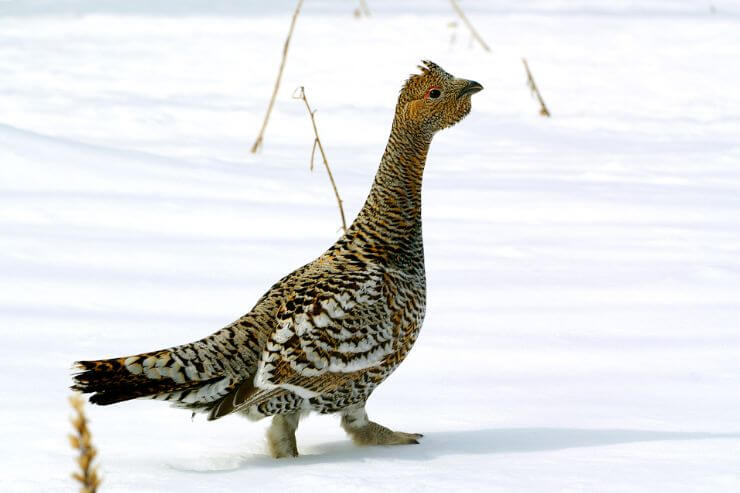
Description: Black-billed Capercaillie are large, powerfully built birds in the grouse family. They have glossy black heads and chests with red “combs” above their eyes. The rest of their upperparts and underparts are brow. They have long tails with large white spots, and their wings also feature smaller white spots. Male displays with neck stretched upward and broad black tail tilted up and fanned.
Black-billed Capercaillies have black bills, brown eyes, and feathered legs. Females are smaller, with brown heads and necks and black-striped bodies and larger spots on their wings.
- Length – 35.04-38.2 in (89-97 cm)
- Weight – 118.2-161.6 oz (3,350-4,580 g)
Similar to Western Capercaillies, which are slightly larger and have longer bills and tails than the Black-billed Capercaillies, their ranges do not overlap.
Habitat: Black-billed Capercaillies inhabit boreal forests, pine forests, cedar forests, and mixed forests of deciduous conifers with park-like birch trees.
Males and females have different winter habitats. Males typically dwell in the lower foothills, where sparse dwarf pine and birch trees are found, while females prefer the higher ridges, characterized by taller larch forests and small openings.
Conservation: IUCN has listed the Black-billed Capercaillie as Least Concern (LC).
Distribution: Black-billed Capercaillies are found in eastern Siberia, as well as parts of northern Mongolia and China.
5.3. Caucasian Grouse (Tetrao mlokosiewiczi)

Description: Caucasian Grouses primarily have black plumage with striking bright red “combs” above their eyes. They feature small white shoulder patches and possess long, deeply forked tails that curve downward. Their eyes are dark brown, their bills are black, and they have feathered legs. Females are smaller than males and exhibit grayish-brown plumage with dark barring and small white patches on their shoulders.
- Length – 19.7-21.7 in (50-55 cm)
- Weight – 28.9-35.5 oz (820-1,005 g)
Habitat: Caucasian Grouses typically inhabit the transition zone between the upper limits of mountain forests and subalpine meadows, characterized by thickets of rhododendrons and stunted birch.
Conservation: The IUCN has classified the Caucasian Grouse as Near Threatened (NT) due to holiday home developments leading to road construction in their mountainous habitat. This fragmentation disrupts their living space and increases access for hunters and herders, threatening the species. Additionally, 40% of the subalpine meadows in their range are impacted by intensive grazing.
Distribution: Caucasian Grouses occur in extreme southeastern Europe and adjacent regions, breeding in the Caucasus and Pontic Mountains of northeast Turkey and Iran.
5.4. Western Capercaillie, also Eurasian Grouse (Tetrao Urogallus)
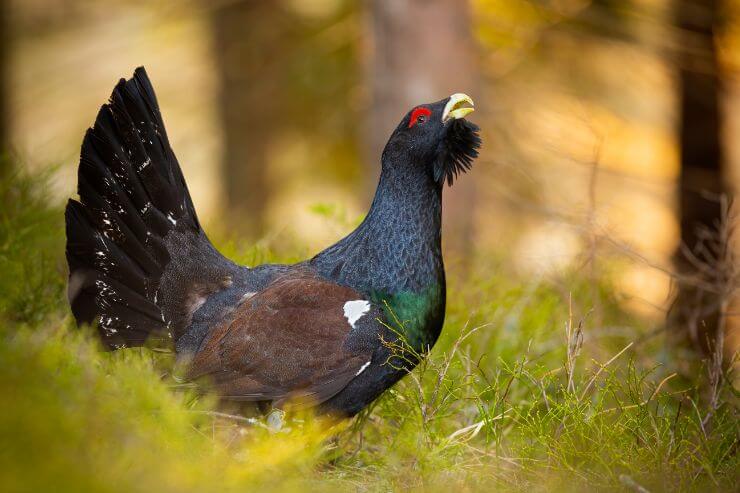
Description: Western Capercaillies are the largest of the extant grouse species. Males have blackish upper parts with red “combs” above their eyes and long tails. They have white shoulder patches. Their wings are dark brown. They have metallic green breasts and bellies and a variable amount of white on the upper and lower coverts and underparts. Their tails are long and rounded.
Western Capercaillies have ivory-white bills and brown eyes, as well as feathered legs. Females are significantly smaller than males. The upper parts of females are brown, featuring black and silver barring, while their underparts are lighter with a buffish-yellow hue. Their breasts are a warm brown color without any barring.
- Length – 31.5-45.3 in (80-115 cm)
- Weight – 116.4-151.7 oz (3,300-4,300 g)
Similar to the Black-billed Capercaillies. Eurasian Capercaillies are larger and have longer bills and longer tails than Black-billed Capercaillies. Their ranges do not overlap.
Habitat: Western Capercaillies are found in forests and woodlands, primarily in coniferous or mixed coniferous-deciduous forests. They are also seen in nearby moorlands and clearings with shrubs, usually in more remote areas. In winter, they may use more open forests, while in summer, they prefer denser forests with an abundance of fruit-bearing bushes.
Conservation: IUCN has listed the Western Capercaillie as Least Concern (LC).
Distribution: Western Capercaillies have an extremely large range, found across Europe and the Palearctic.
6. Genus Tetrastes
6.1. Hazel Grouse (Tetrastes bonasia), also (Bonasa bonasia)

Description: Hazel Grouses are small members of the grouse family, characterized by variable gray upperparts adorned with fine dark barring on their crowns, necks, mantles, and upper tail coverts. Their crowns are brown and feature short erectile crests along with broad white malar stripes. They also have white stripes located just behind their brown eyes and a whitish stripe on their shoulders.
The throats of Hazel Grouses are black, bordered with white, and their underparts showcase a scalloped pattern that is barred or speckled with dark gray and ochre. Additionally, their gray tails are relatively long and rounded with black subterminal bands. They have grayish-black bills and feathered legs. Females are similar to males but are much smaller, have smaller crests, and lack the black throat, instead having a white, speckled throat.
- Length – 13.8-15.7 in (35-40 cm)
- Weight – 10.8-15.2 oz (305-430 g)
Habitat: Hazel Grouses inhabit dense, damp, mixed deciduous-coniferous woodland, preferably with some spruce.
Conservation: IUCN has listed the Hazel Grouse as Least Concern (LC).
Distribution: Hazel Grouses are found across the Palearctic, ranging from Hokkaido to eastern and central Europe.
6.2. Severtzov’s Grouse, also Chinese Grouse (Tetrao sewerzowi)

Description: Severtzov’s Grouses are the smallest grouse species in the world. They are stout, hazel-crested grouse with mostly brown plumage and broad black bars on the upper parts, as well as extensive white and black patterning on their bellies. Their short square tails have different barred patterns. They have thin, red “combs” above each eye and black throats with white-lined borders.
Females are similar to males, but they are smaller and do not have black chins. They have dark brown eyes, black bills, and feathered legs.
- Length – 13-15.37 in (33-40 cm)
- Weight – 9.84-13.76 oz (279-390 g)
Similar to Hazel Grouses. Severtzov’s Grouses have less white on their throats and no black near the tips of their tails.
Habitat: Severtzov’s Grouses inhabit mountainous forests composed of birch, coniferous, and deciduous trees, which provide a good cover of shrubs for their food. In some areas, they can reach the tree line and, during summer, even inhabit the alpine belt in rhododendron regions.
Conservation: IUCN has listed Severtzov’s Grouse as Near Threatened (NT) due to large-scale forest clearance and intensive livestock. Illegal hunting and egg collecting may also be problems in parts of its range.
Distribution: Severtzov’s Grouse are endemic to central China.
7. Genus Tympanuchus
7.1. Sharp-tailed Grouse (Tympanuchus phasianellus)
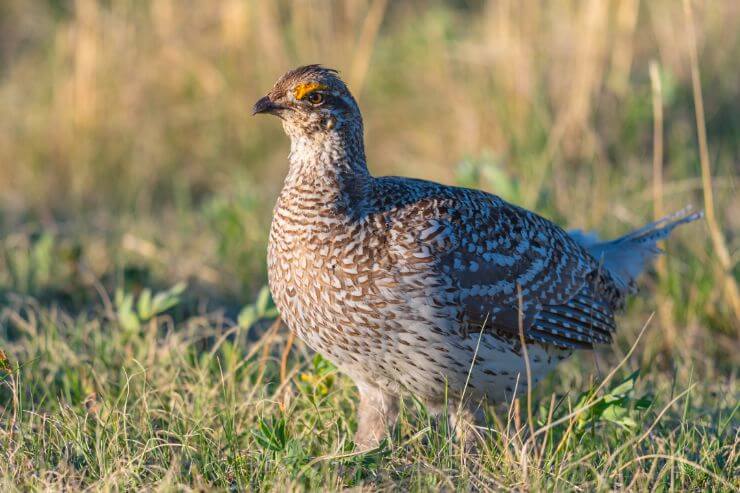
Description: Sharp-tailed Grouses are medium-sized birds found in the prairie region, characterized by their rounded bodies. They have relatively short tails, characterized by square-tipped central feathers and lighter outer tail feathers that taper to sharp points. Their upper bodies are strongly mottled with dark and light browns against a white background, while their underparts are lighter, with white bellies marked by faint V-shaped patterns. Adult males have a yellow comb over their eyes and exposed pinkish to pale violet Gular air sacs on each side of their necks.
Sharp-tailed Grouses have light brown eyes, grayish horn upper mandibles, gray to pinkish-brown lower mandibles, and feathered legs. Females are typically smaller than males and have less pronounced combs, as well as regular horizontal markings across their tail feathers.
- Length – 16.1-18.5 in (41-47 cm)
- Weight – 21-36.4 oz (596-1,031 g)
Similar to:
- Lesser Prairie-Chickens, Greater Prairie-Chickens. The stripe-like marks on the underparts of the Sharp-tailed Grouses are vertical; on the prairie chickens, they are horizontal.
- Ring-necked Pheasants. Female Ring-necked Pheasants and female Sharp-tailed Grouses are similar. Ring-necked Pheasants have longer tails.
Habitat: Sharp-tailed Grouses inhabit prairies, grasslands, agricultural areas, bogs, and open woodlands during the summer. In winter, they migrate to higher elevations, where they find taller shrubs and open wetlands.
Conservation: IUCN has listed the Sharp-tailed Grouse as Least Concern (LC).
Distribution: Sharp-tailed Grouse range from Alaska to Matagami, Canada, extending to the Beaufort Sea and Hudson Bay. In the U.S., they extend south to northwest Kansas, covering western Nebraska and eastern Wyoming.
7.2. Greater Prairie-Chicken (Tympanuchus cupido)
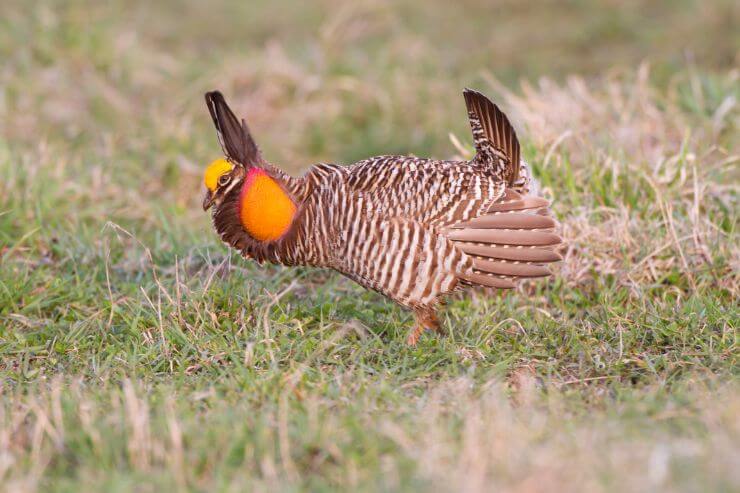
Description: Greater Prairie-Chickens are medium to large birds that resemble domestic chickens in appearance. They are characterized by their rounded wings and small heads, which have distinctive orange, comb-like feathers above each eye. Their bodies and wings are covered in barred brown plumage, while their throats are a lighter buff color. The birds have short, rounded tails and crowns that lack the barring seen on their bodies. Additionally, they have long pinnae feathers on the sides of their necks. During courtship displays, these pinnae feathers are raised to reveal bright orange Gular sacs that inflate. At the same time, the birds lower their wings and elevate their tail feathers.
Greater Prairie-Chickens have brown eyes and bills that range from light to olive gray, featuring lighter tips. Their legs can be beige or orange. While females resemble males, they are slightly smaller and have barred patterns on their heads and tails, which helps to distinguish them. Additionally, females do not have the orange “combs” and orange neck patches found in males.
- Length – 16.9-18.5 in (43-47 cm)
- Weight – 31.7-38.8 oz (900-1,100 g)
Habitat: Greater Prairie-Chickens inhabit areas that combine small patches of oak woodland and extensive prairie.
Conservation: The IUCN has listed the Greater Prairie-Chicken as Near Threatened (NT) due to habitat loss resulting from the conversion of prairie land to cropland. Additional threats include grazing pressure from sheep and the expansion of cropland into native prairie areas.
Distribution: Greater Prairie-Chickens are native to North America, existing from Canada to the southern United States.
7.3. Lesser Prairie-Chicken (Tympanuchus pallidicinctus)

The Lesser Prairie-Chickens are medium to large birds that resemble domestic chickens in appearance. They are characterized by their rounded wings and small heads, which have distinctive yellow, comb-like feathers above each eye. Their bodies and wings are covered in barred brown plumage, while their throats are a lighter buff color. The birds have short, rounded tails and crowns that lack the barring seen on their bodies. Additionally, they have long pinnae feathers on the sides of their necks. During courtship displays, these pinnae feathers are raised to reveal dull reddish Gular sacs that inflate. At the same time, the birds lower their wings and elevate their tail feathers.
Lesser Prairie-Chickens have dark brown eyes and bills, and their legs are yellowish-orange. While females resemble males, they are slightly smaller and have barred patterns on their heads and tails, which helps to distinguish them. Additionally, females do not have the orange “combs” above their eyes, and reddish neck patches found in males.
- Length – 14.96-16.1 in (38-41 cm)
- Weight – 27.0-33.0 oz (765-935 g)
Habitat: Lesser Prairie-Chickens inhabit areas with sand sagebrush and shinnery oak, as well as various grasses and shrubs, depending on the location.
Conservation: The IUCN has listed the Lesser Prairie-Chicken as Vulnerable (VU) due to habitat loss, tourism impacts, and road development, which have altered their natural environment. Intensive grazing has also impacted food and cover, and herbicides have reduced shrub cover and acorn production. Market hunting also has a huge impact on these birds.
Distribution: Lesser Prairie-Chickens are native to the southern and central high plains of the United States, inhabiting areas of southeastern Colorado, western Kansas, west-central Oklahoma, eastern New Mexico, and the Texas Panhandle.
8. Genus Lagopus
There are three species of ptarmigans: the Rock Ptarmigan, the White-tailed Ptarmigan, and the Willow Ptarmigan. The Red Ptarmigan was once classified as a separate species but is now considered a subspecies of the Willow Ptarmigan. All species are found in circumpolar regions. During the snowy season, part or all of their plumage turns white, providing camouflage. Like many game birds, most of the care for the young is performed by the females.
8.1. Rock Ptarmigan (Lagopus muta)

Description: Rock Ptarmigans are plump, chicken-like game birds that change their plumage with the seasons. In summer, males display brownish-gray upperparts that are finely barred, along with white wings and underparts. They have prominent reddish ‘eyebrows,’ known as combs, and display black streaks between their eyes and bills. Females, on the other hand, exhibit more cryptic patterns characterized by shades of brown, black, and buff. Additionally, males possess erectile crests, which are smaller in females.
In winter, Rock Ptarmigans become completely white except for their black outer tail feathers, black lores, and reddish eyebrow combs. They have white feathers on their legs and feet, which function like natural snowshoes. Their eyes are dark brown to black, and their bills are black in color.
- Length – in (34-40 cm)
- Weight – oz (448-880 g)
Rock Ptarmigans are similar to Willow Ptarmigans, but they are typically found on rocky mountainsides and in the tundra, whereas Willow Ptarmigans do not inhabit areas above the tree line. Willow Ptarmigans are slightly larger and possess thicker bills. Additionally, in summer, Willow Ptarmigans exhibit a browner plumage than Rock Ptarmigans.
Habitat: Rock Ptarmigans inhabit arctic and alpine tundra with rocky, sparsely vegetated areas containing low-growing plants.
Conservation: IUCN has listed the Rock Ptarmigans as Least Concern (LC).
Distribution: Rock Ptarmigans are found in the Arctic and subarctic regions across three continents: North America, Europe, and Asia.
8.2. White-tailed Ptarmigan (Lagopus leucura)
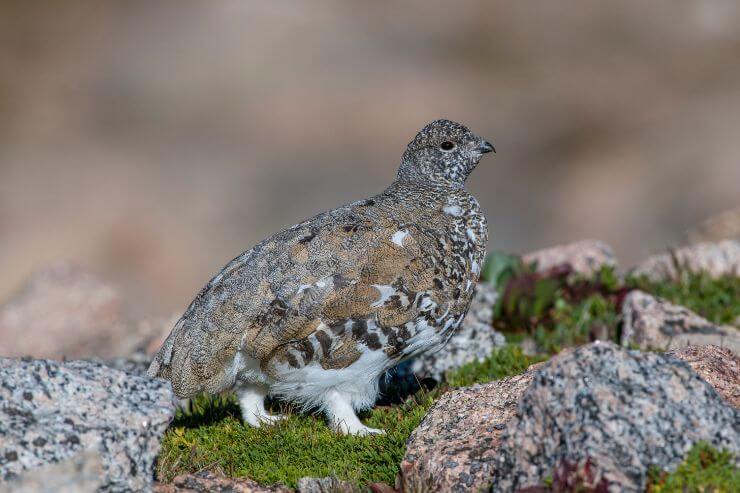
Description: White-tailed Ptarmigan are the smallest of the grouse family, and their plumage varies throughout the year. In the summer, they are speckled with gray, brown, and white, whereas in winter, they are entirely white. Their consistent plumage throughout the year is characterized by their white wings, bellies, and tails. These are the only species of grouse with white retrices.
During the breeding season, male White-tailed Ptarmigans display distinctive “collars” of brown and black breast feathers that are roughly barred. In contrast, females exhibit brown and black plumage with yellow barring. Generally, male plumage appears browner or grayer compared to that of females. Additionally, males have prominent scarlet “eye combs” that are more visible during the breeding season, while females have smaller eye combs. In winter, both sexes develop heavy plumage on their feet, forming a type of snowshoe that makes it easier for them to walk on the snow, as they tend to walk more than fly during this season. Females are generally smaller than males.
- Length – 11.8-12.2 in (30-31 m)
- Weight – 11.6-16.9 oz (330-480 g)
Habitat: White-tailed Ptarmigans inhabit mountaintops characterized by alpine rocks and tundra, where willow growth can be seen above the snow in winter. In the summer, they are found in areas where the snow has melted and where there is abundant tall willow shrub cover. These areas have a higher density of subshrubs, moss, and boulder cover compared to non-breeding regions, often due to their proximity to water.
Conservation: IUCN has listed the White-tailed Ptarmigans as Least Concern (LC).
Distribution: White-tailed Ptarmigans are an alpine species that ranges from Alaska and western Canada south to northern New Mexico.
8.3. Willow Ptarmigan (Lagopus lagopus)
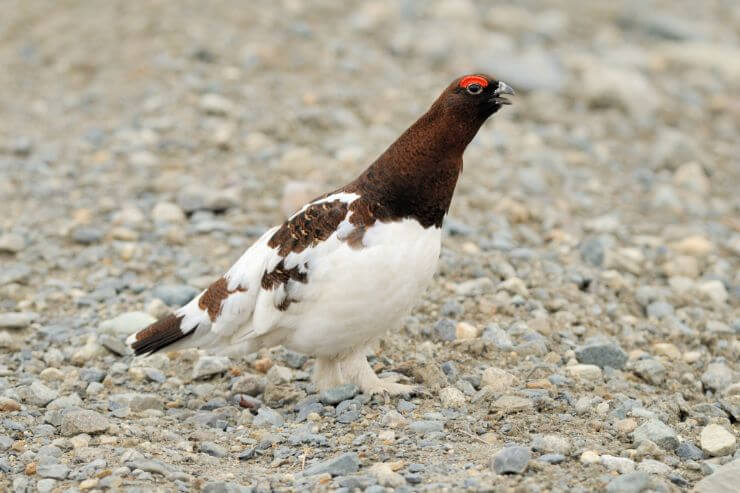
Description: Willow Ptarmigans are stout birds and are known as Alaska’s state bird. They have plumage that changes seasonally. In summer, males showcase vibrant rufous heads and necks, along with brownish backs, black tails, and white wings and underparts. In winter, their feathers turn entirely white, except for the black tail feathers. They also have red combs above each eye that become more vivid during the breeding season, along with their scarlet crests.
Willow Ptarmigans’ eyes range from dark brown to black, and their feet are feathered throughout the year. Female Willow Ptarmigans are slightly smaller than the males. Like males, females also change their plumage with the seasons, but they lack combs and have smaller crests.
- Length – 13.78-17.1 in (35-43.5 cm)
- Weight – 15.17-28.6 oz (430-810 g)
Habitat: Willow Ptarmigans primarily inhabit subalpine and subarctic areas such as sparse pine and birch forests, thickets of willow and alder, tundra, and mountain slopes. In winter, females and sub-adults often move to lower altitudes for shelter, while adult males typically stay in the subalpine region.
Conservation: IUCN has listed the Willow Ptarmigans as Least Concern (LC).
Distribution: Willow Ptarmigans are native to Canada, the United States, China, Mongolia, the Russian Federation, Kazakhstan, the Czech Republic, Finland, Norway, Sweden, Estonia, Latvia, Lithuania, Germany, the United Kingdom, and Ireland.
Conclusion
Grouse are fascinating birds that significantly impact their ecosystems and contribute to local tourism. Their unique behaviors and courtship displays attract ornithologists and nature enthusiasts. As herbivores, grouse feed on a variety of plants, influencing vegetation growth and contributing to seed dispersal.
Conservation efforts are essential for the survival of various grouse species, which face threats from habitat loss, climate change, and hunting. By understanding and protecting these remarkable birds, we can preserve the rich biodiversity they contribute to and ensure that future generations can enjoy their presence in the wild.


